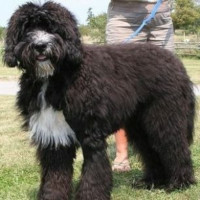Appearance of the Newfypoo
|
| Most Newfypoos will be large dogs, some even reaching heights and weights that will classify them as giants. As a general rule, dogs will be more streamlined and slimmer than the Newfoundland Dog, inheriting the more elegant silhouette of the Poodle. Their skulls and muzzles are less broad than those of the Newfoundland, although they are still wider than the average dog. They have deep oval eyes that are relatively small compared to their large skulls. Their ears are large and pendulous, often densely furred. Their body is rectangular and they should have long, straight limbs. Their tails will reach their hocks, often curving at the top. When fully grown, the Newfypoo will weigh between 30 and 68 kg and reach an average height of 53 to 61 cm, with some of the breed's dogs being considerably taller. The Newfypoo's coat may be hypoallergenic, although this is never guaranteed and some dogs shed a small amount. Their coat is of medium length and generally has a shaggy, dense appearance, whether in waves or curls. A wide variety of coat colors are possible, including black, brown and cream. Although coat colors are uniform, many Newfypoos combine two colors, a black and white coat being popular at the moment. |
Temperament of the Newfypoo
|
| It's harder to predict a hybrid's temperament than a pedigree's, but many Newfypoos share similar personality traits. As a general rule, they are friendly and easy-going. Once well socialized, they'll want to mix with anyone and generally accept people of all ages, making them a good companion for older children. Young children need constant supervision in their presence, purely because of their size and strength. They will be fiercely loyal and protective of their families. Although they rarely show hostility to an intruder, their impressive size and deep voice are often enough to scare others away. Alert and highly intelligent, the Newfypoo loves to participate in family life and takes every opportunity to join in an activity or learn a new trick. They don't like to be left on their own for too long, and can get bored if not sufficiently stimulated. |
Needs and activities of the Newfypoo
|
| The Newfypoo is a rather active dog, even if not hyperactive, and generally needs about an hour of vigorous exercise a day to stay healthy and fit. It's important to remember that very large and giant breed dogs have particular exercise requirements, especially as they grow, and excessive jumping or maneuvering can be detrimental to the development of their bones and joints. While walks and jogging are always appreciated, these dogs can also enjoy alternative activities such as tracking or truffle hunting, and will certainly have a natural love of water sports, which is excellent exercise for increasing cardiovascular endurance and building muscle without stressing joints. |
Maintenance of the Newfypoo
|
| This crossbreed doesn't generally require frequent bathing, once every two to three months is usually enough to keep them looking and smelling clean. However, the Newfoundland's mantle is known to attract dirt and debris, and it may be necessary to trim or clip the Poodle's mantle frequently due to its continued growth. It is therefore necessary to brush and comb daily to avoid any risk of matting and to remove loose hairs or debris. Newfypoo's folded or hanging ears should also be checked regularly to ensure they are clean, dry and free from infection. These dogs are also prone to a condition known as bloat. The way they eat can therefore be an important part of their maintenance. Serving your dog several smaller meals a day rather than one or two larger ones is less likely to cause this life-threatening condition, and using specialized food bowls that force your dog to slow down when eating can help ensure proper digestion. |









 English (United Kingdom)
English (United Kingdom)